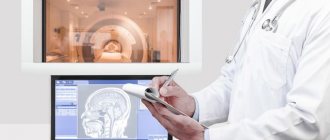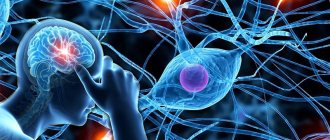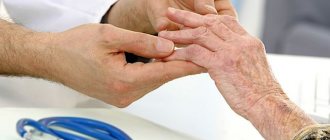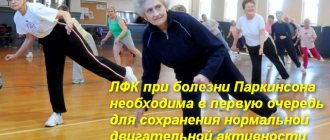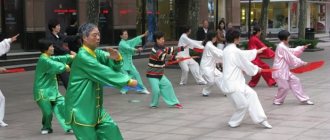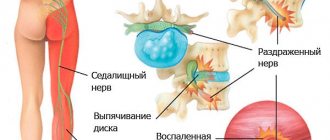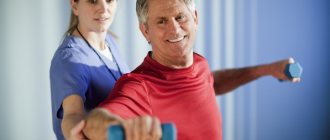Multiple sclerosis (MS) is a severe, disabling disease of the nervous system that most often affects young and middle-aged people. Due to the fact that the exact cause of this disease has not yet been identified, its complete cure is impossible. Nevertheless, drug therapy, physical rehabilitation, and exercises recommended for multiple sclerosis can slow down the progression of the process.
Why is physical exercise needed for MS?
The essence of the disease is the development of an autoimmune reaction: the body’s own immune cells damage the sheath of the nerve fibers of the brain and spinal cord. The conduction of the impulse slows down, and a variety of MS symptoms appear, directly depending on the location of the damage:
- Decreased muscle strength in the trunk and limbs;
- Movement coordination disorders;
- Blurred vision;
- Change in sensitivity;
- Speech impairment;
- Seizures;
- Urinary and fecal incontinence;
- Intellectual decline (patients are slow to think and quickly forget the simplest things);
- Mental instability.
It is very important to start treatment in time, when it is still possible to reverse the process. In addition to special medications, physical therapy, which doctors prescribe for multiple sclerosis, plays an important role. It is necessary for the formation of feedback: when you perform any set of exercises, a nerve impulse from the working muscle enters the brain and stimulates the areas that are responsible specifically for its activity.
Even if a certain area of the brain is damaged, neighboring areas can partially take over its function. But for this, training must be regular and systematic. A physical therapy doctor will help you choose the right set of physical therapy for patients with multiple sclerosis.
Another problem is that, against the background of the appearance of muscle weakness (paresis) and disturbances in the mechanism of movement, secondary changes begin in the musculoskeletal system. Due to improper load on the joints and spine, the first signs of osteochondrosis and arthrosis appear - narrowing of the joint space and subchondral sclerosis of the endplates on an x-ray. Adequate physical activity will help avoid such complications.
What's happened?
Multiple sclerosis is a neurological disease that has a chronic form. It is recognized by its characteristic symptoms:
- constant feeling of tiredness;
- poor memorization and reproduction of information;
- causeless occurrence of depression;
- deterioration of health: dizziness, cramps;
- the appearance of a sore throat when trying to swallow;
- urinary incontinence.
If such problems arise, you should immediately contact a neurologist for a diagnostic examination and selection of complex therapy. An integral component of it is physical therapy for multiple sclerosis.
The most common cause of multiple sclerosis is a weakened nervous system. Each cell of the body cannot resist infection, which is why neurological cells are destroyed.
General principles of therapeutic exercises for patients with multiple sclerosis
During the treatment of multiple sclerosis with physical activity, you need to adhere to some general recommendations:
- Strictly dose physical activity; you should not overwork. If signs of fatigue appear, you should stop training.
- Each patient requires an individual approach. Manifestations of multiple sclerosis are very diverse, both in the severity of symptoms and in their essence. A gymnastics complex for a patient with coordination disorders will be significantly different from a workout with paralysis of half the body.
- Moving from one position to another during exercise must be done with great care. Use support if necessary.
- There is no need to exercise just before going to bed - this can cause insomnia.
- For paresis, a combination of massage and exercise therapy is effective.
- Make sure you breathe correctly during exercise, it will make the workout much more effective.
Exercises to strengthen the body
Strength training is essential for every person with multiple sclerosis. They allow you to achieve:
- Body strengthening;
- Increased muscle mass;
- In addition, they can instantly overcome fatigue and improve self-esteem.
Scientists have proven that strength training causes the body to produce happiness hormones, which means that a person who exercises regularly will be less susceptible to stress and depression.
Strength training and exercises for MS include the use of dumbbells and cuffs that are placed on the legs. It is worth noting that this is quite a large load for a person, so it is recommended to exercise only in a gym under the supervision of a qualified trainer or medical professional.
In the first stages of strength training, it is recommended to use a minimal load and perform several approaches. The main goal is to achieve mild muscle fatigue. Then, gradually the load can be increased, but it is imperative to take a short rest between approaches to restore the functioning of the respiratory system.
Advantages
Exercise therapy for MS has a number of serious advantages:
- Maintains physical fitness and ability to move;
- Prevents the formation of contractures;
- Tones, increases performance;
- Improves coordination;
- Helps cope with the problem of urinary incontinence by strengthening the muscles of the bladder and rectum;
- Develops the ability to correctly hold a certain body position;
- Normalizes blood supply to the brain and increases its resistance to disease;
- Maintains intelligence for a long time.
This is interesting!
Physical training promotes the production of endorphins - joy hormones - in the brain, which means a lot for patients with multiple sclerosis. According to statistics, 15% of such patients die due to suicide due to prolonged depression. Exercise therapy helps fight anxiety and stress, improves overall mood.
Contraindications to training
A person himself, like no one else, can assess his own well-being: whether he can bear the load, or whether it will make him worse. Obvious contraindications to exercise therapy for MS are viral and cold illnesses, elevated body temperature, severe dizziness or weakness.
It is imperative to consult a neurologist before performing exercises, especially if the patient has other concomitant chronic diseases. The specialist will be able to give an objective assessment of the patient’s health.
A set of exercises recommended for multiple sclerosis
The time of one session of therapeutic exercises performed for multiple sclerosis should not exceed a quarter of an hour. It is advisable to train at least 2 times a day. The pace of execution is leisurely, with rest breaks. It is advisable to alternate active and relaxing elements.
Important!
Throughout the entire workout, you need to monitor your condition and intensity of the load. Since a sick person is not always able to objectively assess the degree of his fatigue, counting his pulse comes to the rescue. A heart rate from 100 to 130 beats per minute indicates a low intensity of exercise, from 130 to 150 – average (optimal), from 150 to 170 – excessive, over 180 – maximum.
Exercises that are performed in the starting position (IP) lying down
Each task must be repeated 3-8 times, depending on the severity of the condition.
- Bend your knees, spread them slightly and place your feet on the floor. Take turns pulling your hips towards your stomach, helping with your hands if necessary.
- From the previous position, tilt both legs, now to the right, now to the left, without lifting your feet, pelvis and entire body from the floor.
- Bring your feet even closer to your buttocks. Raise your pelvis up without lifting your shoulder blades from the horizontal surface.
- Perform the “Bicycle” exercise, simulating pressing the pedals.
- Now do the same exercise, but with one leg - first the right, then the left.
- Lie down straight, legs together, arms out to the sides, palms up. As you twist your spine, cover the palm of one hand with the other. Then vice versa.
- Roll over onto your stomach, rest your head on your forearms. Place your feet parallel to each other, resting on your toes. Lift your right foot from the support, move it over your left, and touch your toes to the floor. Then repeat with your left leg.
- Imitate breaststroke swimming: extend your arms straight forward, then spread them to the sides, raising your head and shoulders. Having made a full circle, extend your arms along your body and bring them forward again.
The following exercises can be performed either lying or sitting
This section contains a number of exercises that are performed with the help of a chair and a gymnastic stick. These exercises can be performed both lying down (against the background of a serious condition) and sitting, if this possibility is preserved. 3 to 8 approaches should also be done.
- Alternately stretch your arms straight up at the elbow and wrist joints.
- Hold a gymnastic stick in your hands so that your upper limbs are parallel to each other. As you inhale, slowly raise it above your head, and as you exhale, lower it.
- At the same time, move the limbs of the same name in your direction.
- Now move the opposite limbs away. For example, the right hand and left leg and vice versa.
- Bend your elbows with support on the bed or armrest. Alternately connect the pads of your thumbs with all the others.
- In the same position, rotate your brushes clockwise and then counterclockwise. Do 4 circles for 3-8 approaches.
- As you exhale, clasp your torso with your arms and pull your feet towards you. As you inhale, lower your arms and spread your feet.
- We clench the fingers of our right hand into a fist and bend our right foot towards ourselves. At this time, the left palm is open and the left foot is bent away from you. Then we swap the limbs: the left hand and foot are bent, the right ones are extended.
Exercises that are performed in the starting position (IP) while sitting
These tasks are intended for patients who have retained the ability to sit and maintain balance. The number of repetitions is similar – from 3 to 8.
- Sit straight on a chair with a back, lower your arms parallel to your body. Lean forward slightly, lifting yourself off the backrest, then lean back again. In this case, the position of the head and spine should remain level, and there should be no symptoms of dizziness or balance disorders.
- Take a gymnastic stick. Hold it with both hands, placing it on the weight perpendicular to the floor. Touching with straightened arms, move it down and up.
- Now you need to move to the sofa or bed. Smoothly bend your body sideways, while your hands slide along the horizontal surface without leaning on it.
- Transfer body weight from one buttock to the other. Control the condition of the muscles: they should hold the torso upright, only the buttocks move.
- Sit at the table. Place your hands on a soft cloth and stretch forward, sliding them along the table along with the rag, then sit up straight again.
- Place your forearms on the table. Grasp the rolling pin with your palm, holding it at a right angle to the tabletop. Turn the brush so that the rolling pin rests on a horizontal surface, then return it back. Duplicate with your other hand.
- Now hold the rolling pin with both hands, parallel to the table. Forearms lie on a hard surface. Raise the rolling pin up, bending only your hands at the wrist joints.
- Place your hands on your knee joints, lean on them and slowly stand up, straighten up, stand for about 3-5 seconds and slowly sit down again. Then try to complete this task without using your hands, tensing only the muscles of your legs and torso.
After training, take slow breaths in and out for a minute, calming your breathing.
If you have been diagnosed with such a serious diagnosis as multiple sclerosis, you should never despair. The disease progresses differently for everyone; many retain the ability to move and even work until old age. It is important to follow all medical recommendations, do not forget about training and maintain a positive attitude.
Stretching exercises
An integral part of the treatment of sclerosis are stretching exercises, which must be performed at least 1-2 times a week. They are needed for the following purposes:
- Improved coordination of movements;
- Giving the body plasticity;
- Improved elasticity and strengthened muscles.
In addition, stretching while listening to melodic music promotes relaxation and improves your mood.
Experienced neurologists recommend that patients with multiple sclerosis do yoga or Tibetan gymnastics. After just a few days of training, instability will disappear and coordination of movements will improve, as a person will learn to listen to his body.
It is absolutely not necessary to go to the gym to improve stretching. The familiar “Birch” exercise is incredibly beneficial for the whole body. To complete it you need:
- Take a lying position on the floor;
- Fix your palms under the level of your shoulder blades;
- Raise your legs up and lift your lower back off the floor.
You need to hold your body in this position for 10 to 30 seconds. If during exercises a muscle spasm (convulsions), tremors, or limbs begin to go numb, then the training must be stopped immediately.
Description of the pathology
The symptoms of the disease depend on the location of the damage to the nerve fibers. Almost always, patients note blurred vision, problems with speech and coordination. The first signs of pathology are:
- fast fatiguability;
- double vision;
- blurred vision;
- gait disturbances;
- deterioration of temperature and tactile sensitivity.
These symptoms disappear after some time and a period of remission begins. In this regard, patients in most cases do not suspect the progression of multiple sclerosis.
Treatment of pathology is carried out with medications that suppress the activity of immune cells. The patient's condition improves with the help of physical therapy aimed at strengthening muscles and maintaining balance through precise exercises.
Physical therapy for patients with multiple sclerosis
Types of physical exercises and means of physical therapy
Physical therapy (PT) plays a leading role in the rehabilitation of patients with multiple sclerosis. The role of exercise therapy is both to correct specific motor function disorders and to reduce the adverse effects of physical inactivity in general, and in the absence of neurological deficit, exercise therapy performs a therapeutic and health-improving function.
The mechanisms of action of physical exercises are associated with a variety of complex mental, physiological and biochemical processes occurring in the body during physical therapy exercises. Dosed muscle loads have a general tonic effect, since the motor zone of the cerebral cortex, sending impulses to the motor system, simultaneously excites the centers of the autonomic nervous system, which leads to activation of the endocrine system, cardiovascular, respiratory, and increased metabolism. In the muscles taking part in movements, trophic regeneration processes improve, since as a result of proprioceptive impulses, blood flow to them increases, oxidative processes are activated, the supply of plastic protein fractions and their absorption increases, and the neurogenic regulation of tissue trophism is restored.
The processes of bone tissue remodeling are also normalized, and the functions of the tendon-ligament apparatus are restored. The influence of exercise therapy on the psyche is characterized by an increase in mood, distraction of thoughts from the disease, and the creation of a mindset for recovery. Exercise therapy is indicated for almost all patients with neurological and neurosurgical pathologies, since exercises that are correctly selected in terms of nature, intensity, and duration of implementation are sure to have a positive effect. Contraindications to exercise therapy are often only temporary and relative.
In the rehabilitation of neurological patients, exercise therapy classes are carried out with the aim of solving two main groups of problems:
1) a general tonic effect on the body, training the cardiovascular system; for this purpose, breathing exercises, nonspecific general strengthening exercises for large muscle groups, and orthostatic function training are prescribed;
2) the impact on the motor defect is carried out taking into account the nature of the underlying disease, the type of motor disorders (spastic or flaccid paresis or paralysis, ataxia, hyperkinesis, etc.), the severity and prevalence of these disorders, the period of the disease, the presence or absence of secondary changes, or complications (contractures, bedsores, synkinesis), concomitant pathology.
Specific targets for exercise include joint range of motion, muscle strength, muscle tone, coordination, and complex motor skills.
Among exercise therapy complexes in the process of rehabilitation of neurological patients, three types of physical exercises are mainly used (gymnastics, applied sports and games), as well as postural exercises (position treatment).
Gymnastics are exercises characterized by an artificial combination of movements and performed from certain starting positions, with precisely prescribed directions, amplitude and speed of movements. These exercises allow you to quite accurately dose the load on different segments of the body; they, in turn, develop muscle strength, joint mobility, and coordination of movements. Gymnastic exercises are characterized by the following characteristics:
— anatomical (exercises for the muscles of the limbs, abdominals, back, neck, etc.);
— methodological orientation (to increase muscle strength, to improve joint mobility, to train balance, coordination, to improve respiratory function, to train the cardiovascular system);
- the nature of the activity (active exercises performed by the patient himself, requiring volitional effort and muscle tension; passive, performed by an instructor, or with the help of the healthy limbs of the patient himself, but without volitional effort and muscle tension of the affected area; active-passive exercises performed; ideomotor - mentally exercises performed);
- the nature of muscle work (static, dynamic). Static work with isometric muscle contraction (that is, without shortening the muscle fiber) is carried out with an effort aimed at squeezing, holding weight, trying to push a heavy object out of place and is accompanied by an increase in not only systolic, but also diastolic blood pressure, and some increase in heart rate. Dynamic work is carried out with isotonic muscle contraction (that is, with a decrease in the length of contracting muscle fibers).
Sports and applied exercises are natural motor actions or their elements (for example, integral household and work activities, running, swimming), which contribute to the restoration of complex motor skills, and also have a powerful general tonic effect. Unlike sports, maximum loads are excluded. Games, as a means of exercise therapy, are aimed at improving motor skills in changing conditions, improving the functions of various analyzers, and have a powerful general tonic and emotional effect. Positional treatment is carried out by giving the limb or torso special corrective positions. Typically, positional treatment is aimed at preventing or eliminating contractures in the joints or pathological synkinesis.
The main forms of exercise therapy are group and individual gymnastics. Individual gymnastics is prescribed for patients with severe movement disorders, as well as when attending group classes is difficult.
Individual gymnastics is aimed at teaching voluntary movement and dosed tension and relaxation of muscles, normalizing coordination and balance, reducing increased muscle tone and eliminating pathological synkinesis, preventing and eliminating contractures, increasing range of motion and muscle strength, and developing compensatory skills. The duration of individual exercise therapy sessions usually averages 15-30 minutes.
Group therapeutic exercises are prescribed to patients with milder movement disorders, for whom the main objectives are to expand the physical activity regime, train the cardiovascular and respiratory systems, improve general and cerebral hemodynamics, and train the vestibular apparatus.
Patients are combined into groups based on the commonality of the type of disease, the nature and severity of motor disorders. The duration of group classes is on average about 30-45 minutes. Each exercise therapy lesson consists of an introductory, main and final part. The introductory part (10-20% of the lesson time) provides for preparing the body for the load ahead in the main part of the lesson and usually includes walking, breathing exercises, and basic exercises for the torso, upper and lower extremities. The main part (60-80% of the time) is aimed at solving problems defined for this group of patients (restoration of specific motor functions, formation of compensations, general training effects). General developmental and special exercises, apparatus exercises, applied exercises and games are used. The final part (10-20% of the time) aims to reduce the physiological load and normalize the function of the cardiovascular and respiratory systems. To do this, use breathing exercises, relaxation exercises, walking, and exercises for the torso and limbs with a slight load.
Methods of active exercise therapy include: therapeutic exercises (restorative, respiratory, reflex, corrective, hydrokinesiotherapy, psychomuscular), ergotherapy, therapeutic walking, exercise therapy classes using computer technology and biofeedback, active mechanotherapy and specialized physical therapy programs.
Methods of passive exercise therapy include: therapeutic massage (reflex, segmental, mechanical) and classical massage (vibration, pneumomassage, hydromassage), positional treatment, passive mechanotherapy (including the use of robotics), manual therapy techniques - vertebrotherapy, joint manipulation , muscular-fascial manipulation, kinesiotaping, extensiotherapy (including traction and decompression of the spine).
A particularly promising direction in the modern concept of neurorehabilitation is the combined use of exercise therapy methods.
In order to increase the physiological load or achieve a more precise local effect, a variety of technical means are widely used in the practice of exercise therapy, which include:
- equipment, objects and simple devices (gymnastic wall, benches, balls, sticks, hoops, cylinders, suspended structures);
— simulators — educational and training devices for the development of motor skills, restoration and improvement of the functions of the musculoskeletal system.
In practice, mechanotherapy using cyclic passive-active exercise machines such as a bicycle ergometer is widely used.
In addition, the following can be used in the rehabilitation process:
— treadmill classes; in this case, a treadmill equipped with stabilometric sensors and an interactive obstacle modeling system and biofeedback technology (BFB) is more preferable;
— classes on stabilometric simulators (verticalizers);
- exercises on an elliptical trainer;
— training in a dynamic parapodium or vertical stand for patients with paraplegia;
— various types of strength training equipment (block, pneumatic, etc.) for individual muscle groups.
Currently, various types of simulators are used in clinical practice - block, pendulum, isokinetic and others.
Block simulators are the most common. Their main purpose is to prevent the development of contractures in large joints (knee, hip, etc.) after fractures and other traumatic injuries that require long-term treatment. Such devices are a system of blocks that allow the patient to train certain muscle groups, performing movements in the joints of a given amplitude. As a rule, such a procedure is highly effective and safe for patients.
Pendulum exercise machines are used for the same purposes - preventing the development of contractures and increasing the amplitude of possible movements in the joints. The positive impact is achieved due to the inertial impact created due to the initial active phase of movement, which allows the pendulum system to be launched. The duration of such physiotherapy should be 15-25 minutes, depending on the patient’s condition.
Isokinetic devices are used to target large muscle groups and are used primarily in athletes after severe injuries. Such devices are based on the resistance of the simulator to active movement of the arms or legs, which allows you to train the musculoskeletal system without performing amplitude movements.
In addition to these devices, there are other methods of mechanotherapy. Available simulators can be either mechanical or robotic systems, controlled through a computer interface.
The use of any technical devices to treat diseases always entails certain risks for the patient. To eliminate them in the process of mechanotherapy, the following rules should be adhered to: the choice of any simulator is always made only by the attending physician, since various devices have their own indications and contraindications, about which the patient may not be informed. When setting the range of motion of the simulator or the level of resistance to the patient’s movements, you should also use the settings chosen by the doctor. Under no circumstances should you change the settings on physiotherapy devices yourself. Otherwise, injury may occur and the patient's condition may worsen. Any exercises should be performed under the supervision of a medical professional, especially during the first exercises on exercise machines, including under the control of such indicators as: blood pressure (BP), heart rate (HR), respiratory rate (RR). If any unpleasant sensations appear, the treatment session should be stopped.
Mechanotherapy devices with high rotation speeds promote a number of positive effects, including improving the quality and ergonomics of walking, fine motor skills, balance and postural stability.
Exercise therapy exercises are fairly unified ergonomic kinesiotherapeutic modules, which are based, one way or another, on individually programmed movements, or a combination of them. Unification is one of the key advantages of physical therapy and health-improving exercises. Certain types of exercises can be used with equal success in patients with various pathologies, but with similar functional deficits. The task of a physical therapy specialist is to select for the patient from a wide range of kinesiotherapeutic modules exactly those exercises that will be most effective and safe at this particular stage of rehabilitation, taking into account the presence of one or another underlying and concomitant pathology in the patient. Thus, despite the similarity of various exercise options, the approach to each patient must be strictly personalized. Next, individual exercise options will be considered.
Exercises while standing
When performing this complex, the legs are shoulder-width apart. It is recommended to perform the exercises 4-8 times. With multiple sclerosis, tilt the head forward, backward and to the sides, then move on to bending and turning the torso. After this, the task is complicated, and while bending forward, the patient must reach the floor with his hands, and then return to the starting position.
The next movement is spreading your arms to the sides while inhaling and lowering your arms as you exhale.
Useful for this disease:
- lunges forward on each leg in turn;
- squats with body weight transferred to the side, leaning on a bent leg;
- lunges to the sides.
Therapeutic exercises for multiple sclerosis include movements while standing on one knee. The other knee and opposite arm should not be in contact with the floor. This exercise improves balance. Multiple sclerosis is a disease that requires daily physical effort; if you train hard, you can lead a normal life; after some time after starting training, you can even engage in regular sports, and not just therapeutic exercises.

